A sensor, internet connection and the ability to communicate: These are the three ingredients that make up the Internet of Things technology. IOT is gaining rapid steam, with companies such as global communication giants, Ericsson and Cisco, making projections of as many of 50 billion devices connected by IOT by 2020.
While estimations vary to the extent of which IOT will be relied upon in the future, one thing is certain – the food industry is not about to get left behind.
Here are four ways food companies are utilizing IOT technology:
Food safety efficiency:
Perhaps the biggest payout for investing into IOT is the ability to closely monitor food safety data points, which in turn helps reduce the risk of a food illness outbreak. Topping the list is the use of real-time temperature tracking sensors that have the ability to monitor a product’s temperature from the time it leaves a farm to the moment it leaves the grocery store shelf.
This type of technology is beneficial as shippers, receivers, loaders and carriers all work to become compliant with the Food Safety Modernization Act’s Final Rule on temperature control and tracking requirements. It also carries over into assisting the tracking of Hazard Analysis and Critical Control Points, and the ability to provide food companies with automated HACCP checklists for more coherent data collection and reporting that paper-based logs are not able to monitor as efficiently.
Less waste:
According to the Food and Agriculture Organization of the United Nations, one-third of human food production is lost or wasted globally each year. While some of this is food waste on the consuming end, food waste due to compromise during the transportation and distribution portion of the supply chain contributes to this whopping 1.3 billion tons per year waste estimation. However, with a centralized cloud data base tracking real-time control points for food safety, companies have the ability to integrate it into their business management decisions. For example, if a load of broccoli from Mexico experienced a temperature compromise during shipment, a company can use that knowledge to decrease the shipment’s shelf life so a retailer can act accordingly to get it on a consumer’s plate before it spoils.
To stay in compliance with FSMA, food companies exceeding $1 million in revenue each year is mandated to keep at least two years of food safety records on file.
It doesn’t stop there, with shippers and carriers required to have on hand 12 months of transportation and training records.
While paper-based records are still industry standard, companies have a lot to gain by moving towards a cloud-based portal with sensors automatically streaming into the online data base to not only cut down on labor, but also human error.
Interconnected data analysis:
While the three previous points all revolve around specific information points, IOT technology has opened the door to endless data analysis by companies.
Consumer trends, logistic data and anything else that can be measure automatically can all be combined together to make more calculated and grounded business decisions.
© Food Safety News
